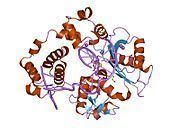Entrez 27343 | Ensembl ENSG00000166169 | |
 | ||
Aliases POLL, BETAN, POLKAPPA, polymerase (DNA) lambda External IDs MGI: 1889000 HomoloGene: 40863 GeneCards: POLL | ||
DNA polymerase lambda, also known as POLL, is a protein found in eukaryotes. In humans, it is encoded by the POLLA gene.
Contents
Function
Pol λ is a member of the X family of DNA polymerases. It is thought to resynthesize missing nucleotides during non-homologous end joining, a pathway of DNA double-strand break repair. The crystal structure of pol λ shows that, unlike the DNA polymerases that catalyze DNA replication, pol λ makes extensive contacts with the 5' phosphate of the downstream DNA strand. This allows the polymerase to stabilize the two ends of a double-strand break and explains how pol λ is uniquely suited for a role in non-homologous end joining. In addition to NHEJ, pol λ can also participate in base excision repair, where it provides backup activity in the absence of Pol β.
Besides its catalytic polymerase domain, pol λ has an 8 kDa domain and a BRCT domain. The 8 kDa domain has lyase activity that can remove a 5' deoxyribosephosphate group from the end of a strand break. The BRCT domain is a phosphopeptide binding domain that is common among DNA repair proteins and is likely involved in coordinating protein-protein interactions. Pol λ is structurally and functionally related to pol μ, another member of the X family that also participates in non-homologous end joining. Like pol μ, pol λ participates in V(D)J recombination, the process by which B-cell and T-cell receptor diversity is generated in the vertebrate immune system. Whereas pol μ is important for heavy-chain rearrangements, pol λ seems to be more important for light-chain rearrangements. The yeast Saccharomyces cerevisiae has a single homolog of both pol λ and pol μ called Pol4.
Interactions
Pol λ has been shown to interact with PCNA.
